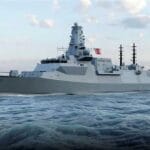GE Aerospace has announced a strategic partnership with Kratos Defense & Security Solutions to develop small-class turbofan engines tailored for future collaborative combat aircraft (CCA). This alliance aims to address propulsion requirements for next-generation uncrewed aerial systems (UAS), particularly those envisioned under the U.S. Air Force’s Next Generation Air Dominance (NGAD) initiative.
Strategic Context: Propulsion as a Bottleneck in CCA Development
The U.S. Department of the Air Force’s CCA program is a central pillar of the broader NGAD effort, which seeks to field a family of systems—including optionally crewed fighters and autonomous wingmen—by the early 2030s. While much attention has focused on autonomy and mission systems integration, propulsion remains a critical enabler. The ability to produce reliable, efficient small turbofans at scale is increasingly seen as a limiting factor in fielding affordable mass.
Unlike traditional fighter jet engines that prioritize thrust above all else, powerplants for CCAs must balance performance with cost-efficiency, modularity, thermal signature management, and manufacturability. This has created demand for a new class of scalable propulsion systems optimized for attritable or expendable platforms.
Details of the GE-Kratos Collaboration
Under the newly announced agreement, GE Aerospace will supply its expertise in engine design and manufacturing while Kratos contributes its experience in low-cost tactical UAVs such as the XQ-58A Valkyrie. The companies will jointly develop and test small turbofan engines intended specifically for uncrewed collaborative platforms.
The collaboration will initially focus on GE’s affordable core technology, which includes compact engine cores derived from commercial-grade components but ruggedized for military use. These cores can be adapted into complete propulsion systems suitable for various CCA configurations—ranging from low-observable strike drones to high-speed reconnaissance assets.
Kratos’ role extends beyond airframe integration; its Scaled Propulsion division has already produced several small engine prototypes suitable for tactical applications. By combining this with GE’s industrial base and certification infrastructure, the partnership aims to accelerate time-to-field while maintaining compliance with military airworthiness standards.
Target Platforms: From Valkyrie to Future CCA Variants
The most likely near-term beneficiary of this collaboration is an evolved variant of the XQ-58A Valkyrie, an experimental low-cost UCAV developed by Kratos under AFRL’s Low Cost Attritable Aircraft Technology (LCAAT) program. Although originally powered by a Williams F107 engine (used in cruise missiles), newer versions may require more capable powerplants offering greater thrust-to-weight ratios and improved fuel efficiency.
The GE-Kratos team may also support future entrants into the USAF’s ongoing CCA competition—currently involving Boeing, Lockheed Martin-Skunk Works, Northrop Grumman-Scaled Composites teams—with each proposing unique designs tailored around different mission profiles such as EW escort or ISR penetration.
- XQ-58B/C: Potential upgraded Valkyrie variants requiring new propulsion options
- CCA Block 1: Initial production units expected mid-to-late 2020s; likely powered by off-the-shelf or rapidly developed engines
- Tactical Surrogates: Testbeds or training drones that mimic CCA performance without full autonomy stack
Industrial Implications: Scaling Up Small Engine Production
A key challenge facing both government and industry stakeholders is scaling production capacity for small military-grade jet engines—a segment historically underserved due to limited commercial crossover. While large turbofans benefit from civil aviation economies of scale (e.g., F135/F110 derivatives), sub-5000 lbf-class engines have seen relatively little investment outside cruise missiles or target drones.
This partnership could help close that gap by leveraging:
- GE’s additive manufacturing capabilities, including ceramic matrix composites (CMCs) and advanced cooling techniques
- Kratos’ rapid prototyping pipelines, proven through programs like UTAP-22 Mako and Air Wolf
- DPA Title III funding potential, if recognized as critical defense industrial base capability by DoD
Operational Considerations: Survivability vs Cost vs Performance Tradeoffs
The propulsion system selected for any given CCA variant must align with its intended operational role. For example:
- A high-speed EW escort drone may require afterburning capability or supercruise potential—raising cost and complexity.
- A loitering ISR platform might prioritize fuel efficiency over top-end speed—favoring bypass ratio optimization.
- An expendable decoy drone could accept lower reliability thresholds if unit cost remains below $3M per copy.
This diversity underscores why scalable engine core architectures are valuable—they allow tailoring thrust class without redesigning entire powerplants from scratch. GE’s modular approach mirrors similar efforts seen in Pratt & Whitney’s Adaptive Engine Transition Program (AETP), albeit at smaller scales suited to unmanned platforms.
Looking Ahead: Timeline and Milestones
No formal timeline has been disclosed yet regarding flight testing or production readiness milestones under this partnership. However:
- The USAF plans initial operational capability (IOC) for first-gen CCAs around FY2028–2029;
- The first prototype flights using new propulsion could occur as early as FY2026;
- If successful, GE-Kratos engines could become candidates not only for USAF but also USN NGAD adjuncts or allied UCAV programs like Australia’s MQ-28 Ghost Bat evolution;
Conclusion: A Critical Step Toward Affordable Massed Airpower
The GE-Kratos collaboration represents more than just another industry teaming—it reflects growing recognition that engine availability is a gating factor in scaling autonomous airpower concepts like CCA. By addressing this head-on through modular design and dual-use manufacturing pathways, both firms position themselves at the heart of future air dominance architectures where human-machine teaming becomes operational reality rather than concept art.








